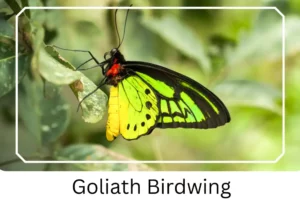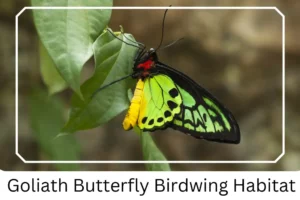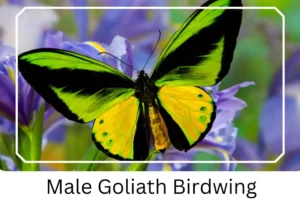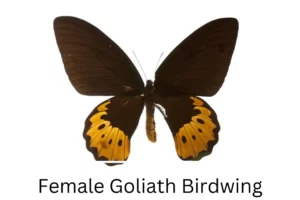Goliath Birdwing (Ornithoptera goliath)
The Goliath Birdwing butterfly, known scientifically as Ornithoptera goliath, stands as the second largest butterfly species in the world, surpassed only by the majestic Queen Alexandra’s birdwing. This remarkable species, with its vivid colors and grand size, captivates the hearts of both researchers and butterfly enthusiasts alike. Found in the lush, tropical rainforests of New Guinea, the Goliath Birdwing is not only a marvel of nature but also plays a crucial role in the local economy through sustainable farming practices by the indigenous people.
Scientific Classification
- Family: Papilionidae
- Genus: Ornithoptera
- Scientific Name: Ornithoptera goliath
Overview
Despite its beauty, the Goliath Birdwing holds the title of the second most poisonous butterfly, a defense mechanism that ensures its survival against predators. The intricate relationship between this butterfly and its environment showcases a fascinating example of nature’s balance. This guide explores the life cycle, identification, and fascinating aspects of the Goliath Birdwing, offering a comprehensive overview for anyone looking to deepen their understanding of this splendid creature.
Description and Identification
Caterpillar
The journey of the Goliath Birdwing begins with its caterpillar stage, characterized by a dark brown hue and adorned with spine-like protrusions. These caterpillars are known for emitting a distinct odor when threatened, serving as an effective deterrent against predators. As they grow, they undergo up to five molts, transitioning from feasting on tender, new leaves to the tougher, older ones, and eventually, the bark of stems.
Pupa
Transitioning to the pupa stage, the chrysalis mimics the appearance of a dead leaf, a camouflage strategy to evade detection. Suspended by silk from the underside of leaves, the chrysalis undergoes a transformation, emerging as a butterfly after 3-4 hours of painstaking efforts to pump blood into its wings, preparing for its first flight.
Adult Butterfly
Sexual Dimorphism: The adult stage of the Goliath Birdwing exhibits a striking sexual dimorphism. Males and females display vastly different color patterns, making them easy to distinguish.
Color and Appearance: Males boast an iridescent green on their dorsal wing surfaces, with distinctive black and tan orange markings. Females, on the other hand, are adorned with a chocolate brown, complemented by cream blotches and dots. This contrast is not just a display of beauty but serves various functions, including mate attraction and predator avoidance.
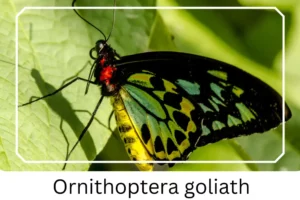
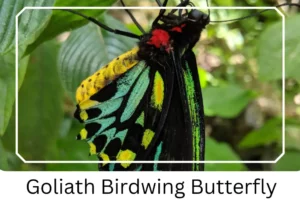 Average Wingspan: With an average wingspan reaching up to 28 cm (11 in), the Goliath Birdwing commands the skies with its size, casting a shadow over many other butterfly species.
Average Wingspan: With an average wingspan reaching up to 28 cm (11 in), the Goliath Birdwing commands the skies with its size, casting a shadow over many other butterfly species.
Flight Pattern: The flight of the Goliath Birdwing is both leisurely and powerful, a testament to its strength and agility, enabling it to navigate through dense rainforests with ease.
Eggs
The reproductive cycle continues with the laying of up to 20 round, dull yellow eggs, strategically placed on the host plant’s leaves or branches, ensuring the next generation’s survival.
Quick Facts | |
| Distribution & Habitat | Exclusive to the dense tropical rainforests of New Guinea and nearby islands. |
| Lifespan of Adults | Approximately 12 months. |
| Host Plants | The specific host plants remain a mystery, contributing to the allure of studying this species. |
| Adult Diet | Primarily consists of flower nectar and flowers, including those of Spathodea campanulata. |
How to Identify Goliath Birdwing?
Identifying a Goliath Birdwing butterfly in the wild can be a thrilling experience. Look for the massive wingspan and the vivid coloration that sets them apart. Males display a bright green on their primary wings, while females show a more subdued brown with cream and yellow accents. The unique flight pattern, leisurely yet controlled, further aids in identification. Observing their habitat can also provide clues; these butterflies are typically found in the dense, humid rainforests of New Guinea, often near flowering plants from which they feed. Noticing the sexual dimorphism can also be a key factor in identification, with the stark contrast between males and females regarding color and appearance.
Did You Know?
- The poison contained within the Goliath Birdwing is potent enough to be fatal to small animals, showcasing nature’s intricate balance between beauty and danger.
- Named after the biblical giant Goliath, the butterfly’s grandeur is reflected not only in its size but also in the names of its subspecies, drawing inspiration from other giants like Atlas, Titan, and Samson.
- The male’s underside features cryptic coloration, making it nearly invisible when resting with wings folded, a remarkable adaptation for evasion from predators. Conversely, females tend to rest with their wings open, displaying their unique color patterns.
Conclusion
The Goliath Birdwing butterfly, with its breathtaking wingspan, vivid coloration, and intriguing life cycle, stands as a testament to the wonders of the natural world. Its existence, however, is tightly woven into the fabric of its native habitat, highlighting the importance of conservation efforts to ensure its survival. Through understanding and appreciating these magnificent creatures, we can foster a deeper connection with nature, recognizing the intricate roles each species plays in the broader ecosystem.
Goliath Birdwing Pictures

Scientific Classification

- Family: Papilionidae
- Genus: Ornithoptera
- Scientific Name: Ornithoptera goliath

